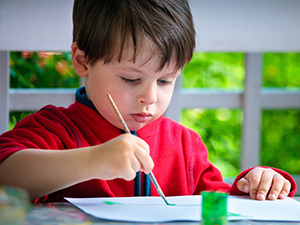Painting – Child
 Painting can help your child learn lots of skills to prepare them for school. Showing off your child’s artwork gives them a sense of achievement, pride and self-worth.
Painting can help your child learn lots of skills to prepare them for school. Showing off your child’s artwork gives them a sense of achievement, pride and self-worth.
Did you know?
While children love to paint, they are also making brush strokes they will use when learning to write. The letter “C” is formed with an anticlockwise stroke. Drawing top to bottom and left to right forms the letter “T”.
Add language
Ask your child “Tell me about your painting”. Give them a chance to tell you what or who is in the picture, where they are and what they are doing. Make comments or ask occasional questions to encourage them to talk more. This can also help develop their storytelling skills.
Other development
Painting is an ideal way for your child to explore their creativity. Talking about feelings during painting helps children recognise and express their emotions creatively.
Mixing colours and using different brushes and materials helps develop reasoning skills and early science concepts.
Painting on a vertical surface helps to develop your child’s balance, core strength, and wrist movements for writing. No easel? No problem! Try taping paper to a large window or paint directly on the glass using washable paint.
Variations
For different and exciting painting ideas, try some of the following:
- Dot painting
- Magic painting with wax crayons
- Blow painting
- Paint on one half of the paper, fold it over, and then open again to see what patterns have been created
- Or make your own fizzy chalk or puff paint (you can find instructions on the internet)
Safety
Non-toxic, washable paint is best for keeping children safe.
Activities listed under “child” are suitable for children 3 years and older. Children of this age enjoy more complex activities where they can develop their skills and use their imagination while playing with friends.

